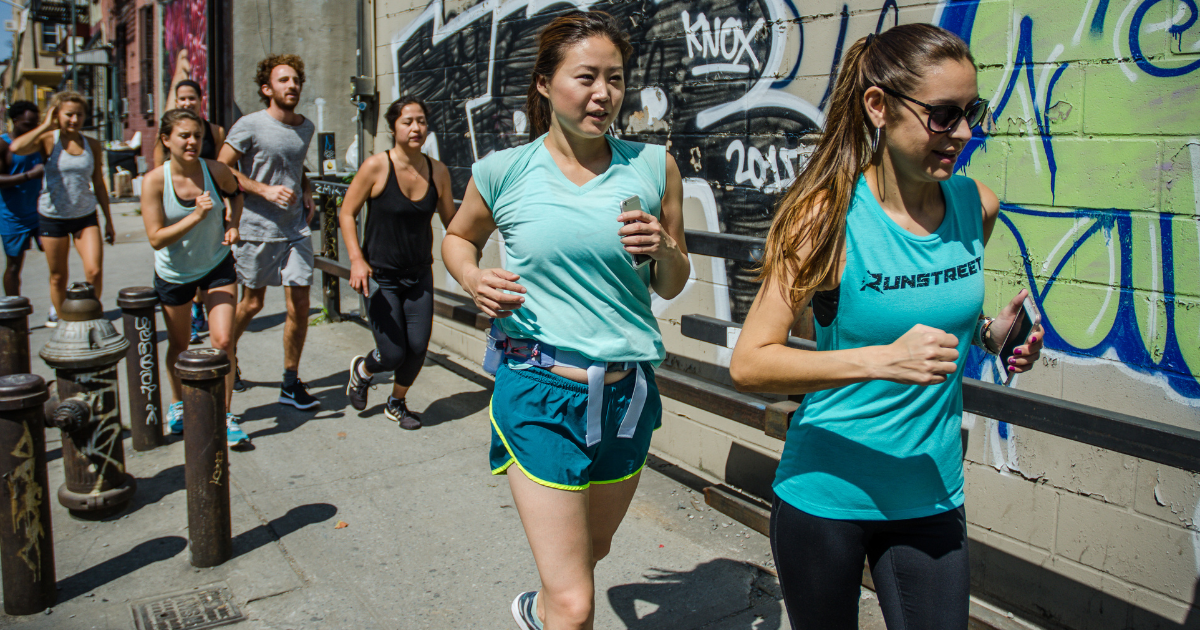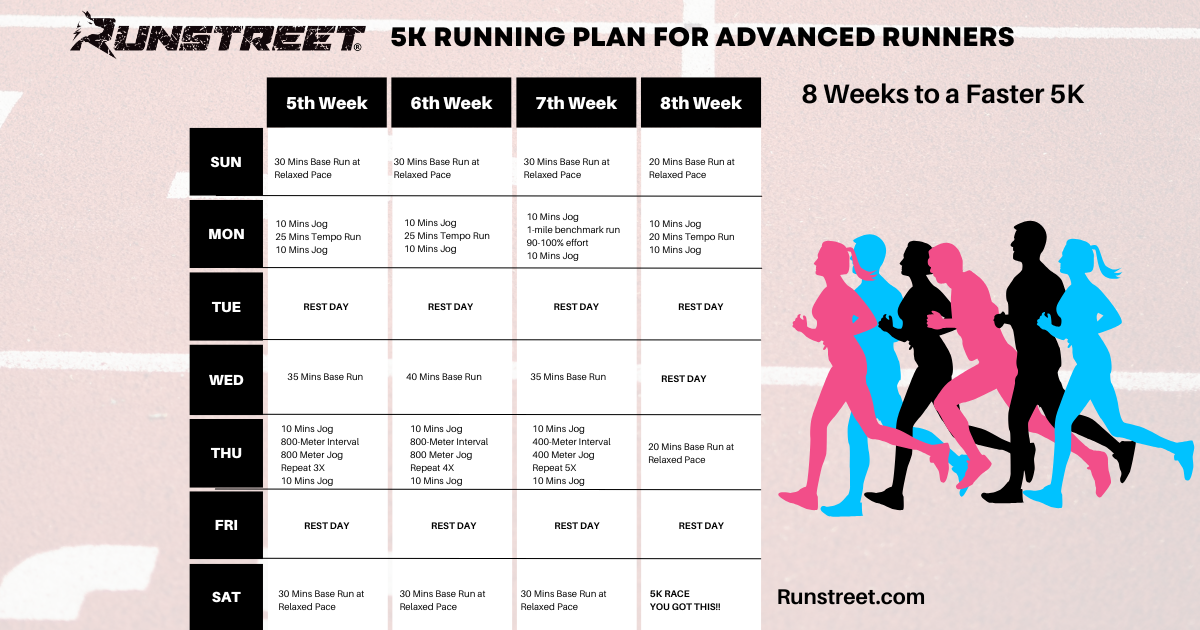5K Running Plan for Beginners to Advanced Runners
Photo by Marques Jackson Photography.
By Marnie Kunz,
Certified run coach and personal trainer
If you’re looking for a 5K running plan, you’ve come to the right place. As a running coach and lifelong runner who started out running 5Ks in cross country, I am a big fan of the 5K. It is a great entry race for new runners as well as an exciting speed race for more advanced runners. Whether you’re just starting out running or you want to get your fastest 5K time ever, these training plans can be adapted to suit all levels. Before we get into the specifics of a 5K running plan, let’s go over the basics of running a 5K.
What Is a 5K?
A 5K race is the most common race distance, and many people refer to 5K races as 5Ks and drop the race part. A 5K can also be a training run, though, as 5K refers to the distance. If you are new to 5Ks, you may be wondering how far is a 5K in miles. A 5K run is 3.1 miles or 5 kilometers.
Training for a 5K Race
If you’re a beginner runner or are easing back into running after an injury or lapse, you will want to focus on building your endurance to train for a 5K. For intermediate runners who already run distances up to 5K and beyond, speed workouts will help you improve your finishing time. I have speed workouts included in the advanced 5K running plan here, and I offer 5 free speed workouts in detail in my post on 5 Speed Workouts for 5K Success.
Running Essentials - Must-Have Gear
Before you pick a training schedule and start your runs, first you'll need some essential gear. First, make sure you have comfortable running shoes that suit your training conditions. A good pair of shoes are the most crucial equipment you need to run well. The best running shoes will reduce your risk of injury, so you can run injury-free.
If you're not sure which shoes to get, go to your local running store to get fitted. A good fitting will assess your gait and running style, where you train (trails, roads, or treadmills), and how far you'll be running.
Related Post: How to Find the Best Running Shoes
Another helpful piece of equipment is a running watch. Brands like Garmin, Coros, Polar, and Suunto all have popular running watches. If a watch isn't in your budget, however, don't worry - there are many free running apps that you can use to track your runs.
For clothing, opt for moisture-wicking running clothes. Dress in layers so you can peel off your outer shell if you get warm. A performance hat and sunglasses are the perfect accessories to help you stay shielded from the elements on your run.
Related Post: What to Wear Running - Checklist from a Run Coach
Choosing Your Training Plan
If you’re not sure which 5K training plan is right for you, consider where you are at with your current training. For beginners and those easing back into running, I recommend going with the Couch to 5K Training Plan. This free 9-week 5K training plan will help you go from walking to run-walking and then running a complete 5K. If you've run shorter distances (such as a mile or 2) or you're running to improve your general fitness and want a lighter training load, this plan is a great option.
If you regularly run 3 or more times a week and you run 3 miles or longer for at least one run a week, then you can go with the 5K Training Plan for Advanced Runners. I know there is a big great area within the two levels, so each training plan can be adapted to different fitness levels.
Couch to 5K Training Plan
The Couch to 5K Training Plan is for new runners and anyone who is currently walking or able to walk for at least 25 minutes. The beginners 5K plan includes run-walking and gradually builds up your running time until you can run a full 5K at the end of 9 weeks. This plan focuses on building your cardiovascular fitness base and endurance to be able to run for a full 5K, or 3.1 miles. The beginners’ training program does not have speed work as it focuses solely on building your fitness base and endurance. For runners who can already run a whole 5K, check out the advanced plan to work on your speed and pacing.
5K Running Plan for Advanced Runners
The 5K Running Plan for Advanced Runners is for people who can already run 5K but want to work on speed. If you have some running experience and have completed 5K races, this plan is for you. The plan will help you run faster paces in your 5K races. The plan includes more intense workouts such as benchmark runs, tempo runs, and intervals. If you're already able to run longer distances and run for the duration of a 5K, the advanced training program will help you PR and includes speed work for each training week as well as base runs.
Here are some helpful terms to know in the plan:
5K intermediate training plan weeks 1 through 4.
Benchmark Run is a speed workout that is also a way to measure your current speed and assess your progress in training. Do a slow jog to warm up and then run at 90 to 100 percent effort level for 1 mile to record your 1-mile benchmark time. Jog to cool down and then stretch.
Tempo Run is a speed workout that involves a steady effort. Do a 10-minute jog to warm up, and then, for your tempo run, aim to run at a consistent pace that is about 70 percent effort level. This will be similar to your 10K race pace.
Intervals are fast-paced running with periods of rest or active recovery jogging in between intervals. When you do interval training, your goal is to consistently run fast times. So don’t go out too fast on your first intervals, but run at a challenging pace that you will still be able to do for later intervals.
400 Meters is one lap around a standard outdoor track or one-fourth of a mile, .25. For the speed workouts in the 5K Running Plan for Advanced Runners, aim to do your 400-meter intervals at 30 seconds faster than your goal 5K pace. So if your goal 5K pace is 8:30-minute miles, for instance, aim for an 8-minute mile pace for each 400, or 2 minutes.
800 Meters is two laps around a standard outdoor track or half of a mile, .5. Aim for your goal 5K pace for each 800-meter interval.
Jog in the training plan means a very relaxed pace. This is a warm-up and cooldown pace and also a recovery pace between intervals.
Base Run is a relaxed pace training run. You should be able to keep up a conversation at this pace. On the RPE effort scale of 1 to 10, with 10 being the highest, your base run should be in the 4 to 5 range. If you are doing heart rate training, your base run should be at 65 to 70 percent of your max heart rate.
5K Training Tips
5K intermediate training plan weeks 5 to 8.
Here are my top tips for 5K training:
Build gradually
Follow your 5K running plan and add distance gradually. When you’re training for a 5K, you want to increase your mileage gradually from week to week. According to the National Academy of Sports Medicine, you should increase your duration or time of exercise by no more than 10 percent each week to allow for a gradual adaptation while minimizing your risk of injury. For runners, this means you should add no more than 10 percent more miles to your weekly running total from week to week. So if you run 10 miles one week, for instance, you can add 10 percent, or 1 mile, to run 11 miles the next week.
Schedule your runs
This running gear checklist will help you dress for success.
When you plan ahead, you’re more likely to stick to your workouts. If you can, plan to run in the early morning, so if you miss your run, you may still be able to get it in later in the day. Also, schedule your rest days so your body has plenty of time to recover from training. If you do a running workout on Mondays, Tuesdays, Fridays, and Saturdays, for instance, you may want to schedule a rest day on Tuesdays, Wednesdays, and Sundays.
Make it fun
Studies show you’re more likely to stick to your workout program when it’s fun. Add music, run with a friend, and share your progress on social media to get cheered on. (Follow and tag me - @Runstreet on Instagram - in your running posts for extra support).
Keep things in perspective
Most people are running 5Ks for fun, fitness, and new challenges, so keep this in mind when you run. Sometimes we get so caught up in the numbers while training and racing that we forget to look at the bigger picture. Signing up for a charity running race or a fun themed run can help you keep your training in perspective.
Practice relaxation
If you get nervous before races or events, learning to relax is crucial. Try some deep breathing exercises to work on your relaxation, or use a meditation app like the Healthy Minds app (my favorite, and it's free!) for meditation exercises.
Stick with your routine on race day
When it comes to race day, stick with your usual things - wear the same shoes you train in, and eat the carbohydrates and protein that you normally eat in the mornings. Make sure you keep your hydration levels up by drinking plenty of fluids the day before your race and leading up to the run (just don't guzzle bottles of water all at once right before the race - space out your drinking).
Check out the course map before your race so you can mentally prepare. Listen to some music to get pumped up as you warm up for your race, do some mobility exercises like dynamic stretches and have a great race! You got this!
Are you running a 5K? If you need a customized 5K training plan to help you slay your race, head to our Training Center.
Happy running to you!😊
Related Posts: How to Do a Tempo Run, How to Train for a Half Marathon, Learning to Run - 10 Tips from a Run Coach
Marnie Kunz is a NASM-certified trainer and USATF- and RRCA-certified running coach based in Brooklyn, a dog lover and Akita mom, and the founder of Runstreet.






